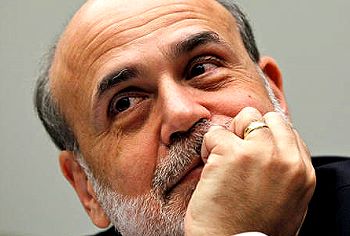
“This is supportive of gold.” Steel added: “The complacency in the financial markets as regards U.S. interest rates suggests that rates are likely to ‘stay lower for longer.’ This is also likely to work against the U.S. dollar.” Read more
Gold’s fate may rest with Fed
“The price of gold is back at record levels,” noted The Wall Street Journal on April 6. “But whether it can hit $1,500 in the next few months could depend on whether the U.S. Federal Reserve sticks with an ultra easy monetary policy that is pushing down the dollar. Right now, the Fed appears divided over the outlook for its quantitative easing program, known to the market as QE2 and scheduled to end on June 30, and the possibility of higher interest rates later this year, even if U.S. unemployment remains high. Any fresh signs that the Fed remains concerned about the U.S. economy would boost gold. … An even stronger signal for gold could come from an extension of the Fed’s program beyond June, which for now, at least, seems likely.” Read morePressing on with money printing
The Fed likely will complete QE2 and perhaps launch QE3, suggested a speech Monday by its vice chairwoman, Janet Yellen. There is no reason for the central bank to reverse course from its current easy monetary policy stance given the spike in commodity prices, Yellen argued. The high unemployment rate still calls for accommodative policy, she said. Even further shocks might not call for any substantial policy shift as long as inflation expectations remain well anchored and measures of core inflation continue to be subdued, Yellen told the Economic Club of New York. Yellen said the Fed isn’t to blame for the spike in commodity prices, noting that prices have grown faster than the dollar has dropped. Read moreTipping point on inflation?
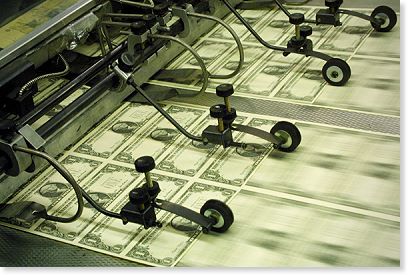
In contrast, recent comments by Dallas Fed branch President Richard Fisher show dissension in the central bank’s ranks over completing its $600 billion QE2 plan. “We at the Fed are near a tipping point,” he said. “Just as we pressed on in doing our duty through extraordinary, exigent measures, we must now discipline ourselves to just as persistently normalize our operations in a timely way. … Inflationary impulses are gaining ground in the rest of the world. My gut tells me that this will result in some unpleasant general price inflation numbers in the next few reporting periods” and “there is the risk that we might breach our duty to hold inflation at bay.” Read more
Sky-high inflation in February?
Maybe Richard Fisher has been reading Shadowstats.com. Inflation hit a jaw-dropping annual rate of 9.6 percent in February, according to pro-gold economist John Williams’ Shadow Government Statistics newsletter, which uses price-analysis methodologies in place before 1980 to calculate a more realistic Consumer Price Index. “Near-term circumstances generally have continued to deteriorate,” Williams said recently. “Though not yet commonly recognized, there is both an intensifying double-dip recession and a rapidly escalating inflation problem.” Investors are anxiously awaiting today’s release of March’s CPI data. Read moreAmericans “fed” up with prices
Whatever today’s official CPI number is, on the streets of America, the debate over inflation is over. “The government says inflation is low, but that’s not what I’m seeing at the grocery store,” said Jorge Alberto, 88, of Miami, walking out of a supermarket. “My pension is being put to the test.” Milwaukee teacher J. McKeever agreed: “I don’t think the Federal Reserve has a clue about us little people. I am very frugal, so I watch what I spend. And what I have noticed in recent months is that I have less money before than I used to, while making the same amount of money and having to pay for health care.” Across the country, Americans tell of a disconnect between the real economy they live in and the macroeconomic picture as described by economic indicators. Read moreGold tames China’s inflation
With Chinese citizens “overwhelmed by anxiety about soaring prices, many residents in the Chinese capital believe they have found a good alternative to hedge against price increases: gold,” reports the Xinhua news agency. “I want to buy some gold to protect my wealth from inflation,” said Feng Chun, shopping at the crowded Caishikou Department Store, the largest gold dealer in downtown Beijing. “Gold is small in size and good for collectible purposes.” Caishikou’s general manager, Wang Chunli, added: “Holding gold is considered by many of our shoppers to be a hedge against inflation. Looking at the crowds inside our store, I believe gold will continue to be a good investment option.” G-Resources Group Vice Chairman Owen Hegarty concurred: “You are now seeing pressure on inflation – not just in China, but all around the world. Gold is one hedge. It is equally a hedge against a declining U.S. dollar. These trends will be with us for a while yet.” Read moreGold climbs on fiscal insanity
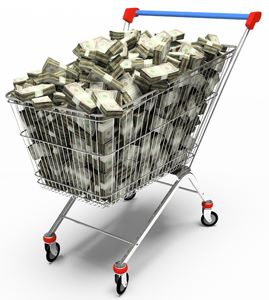
“We don’t watch global exchange rates in our daily lives here,” writes Chicago Sun-Times columnist Terry Savage. “We think in dollars, get paid in dollars and plan for retirement in dollars. But the U.S. dollar is the center of the world’s financial system. And when the world loses respect for America, it shows its displeasure by selling dollars. Where does all that money go when dollars are sold? For starters, it turned to gold, which made new highs, closing [April 8] at $1,475 an ounce. That’s a trend long predicted in this column, as the global money markets seek diversification from the dollar. Where will it all end? Unless fiscal sanity is restored, it can only end with much higher gold prices, and perhaps even with the United States making the dollar convertible into gold again – at substantially higher prices – in order to regain respect for our currency.” Read more
On the road to ruin
Even before debt-ceiling battle really heated up in Washington, Wells Fargo chief economist John Silvia noted that the U.S. is going down a similar road as that taken by Greece and Portugal with regard to its budget decisions. “To me – being in Europe for a few days – the plot in Greece and Portugal sounds an awful lot like the same plot that’s going on in the United States. But the characters have different names.” Read moreBond behemoth shorts Treasuries
“In March, PIMCO’s flagship Total Return Fund (TRF) has now taken an active short position in U.S. government debt,” writes Tyler Durden of Zero Hedge. “This is the first net short position that PIMCO has had in government-related debt since the Great Financial Crisis of 2008, and going positive in February of 2009 only after it became clear that the Fed would commence monetizing U.S. debt one month later. … Alas, as has been made all too clear recently, U.S. debt is no longer the safe haven it once was.” Read moreJohn Paulson: Gold, not real estate
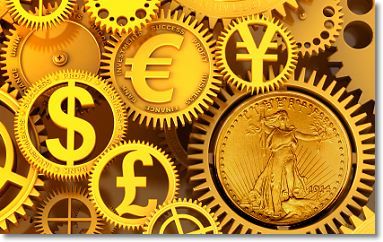
“In my eyes, the major risk for the American recovery is the stagnation of the residential real-estate market,” gold bull and hedge-fund kingpin John Paulson told Paris-based financial newspaper Les Echos. “It will be difficult to have a rebound in real-estate prices this year.” The Federal Reserve’s economic stimulus plan creates a risk of inflation, Paulson said. Because of that risk, the price of gold can rise further, he said. With inflationary risks in the next three to five years and the instability of the euro, gold provides protection against currency devaluation, he said. Read more
The paper-money con
Jay Taylor of Taylor Hard Money Advisors gave a blistering and wildly pro-gold April 7 interview on CNBC:On money printing: “How long can people be conned into believing that paper money is worth something? And I don’t know the answer to that, but the direction is definitely higher for gold and for silver. All the signals now are that we’re going to have an easy monetary policy from virtually every corner of the earth.”
On inflation: “Clearly I think there’s a lot of deception going on in the United States by the policymakers. I think if you look at the real rate of inflation, it’s much higher than what they’re claiming it is. And that being the case, real interest rates are very, very low – are extremely low. So people who save their money and live frugally are being punished. So it’s the Keynesian economic model to try to stimulate consumption without saving, and it’s a road to disaster as far as I’m concerned.”
On precious metals and the dollar: “People are looking to those monetary metals as a store of value. And to me it’s all about a loss of confidence in the currency, and of course there’s going to be a con job to try to keep people interested in buying Treasuries and buying financial assets because the people who run the system are benefiting from paper money. I mean we just heard about these massive salaries that these executives are making. It’s just a reallocation of wealth from the people who create it – the miners, the manufacturers, the farmers, the inventors – to the people who control the system, which is really the banking system and the politicians who are in bed with the bankers.” Watch video
A golden crystal ball
Professional Coin Grading Service numismatist David Hall describes the incredible shrinking dollar in a new, spot-on commentary: “Two months ago when silver was 30 bucks, I went: ‘Darn, I should have bought some silver! Oh gee, you know it’s 30 bucks now. I missed the move; it’s too late. I guess I can’t buy any silver.’ Well, it went up 35 percent since then; it’s now over 40 bucks. It’s an onward march. And that brings me to the crystal ball. … There’s one thing I can personally assure you of. … That is that the price of gold and silver will be more in terms of U.S. dollars in 20 years; it’ll be higher than it is today. It is a 100 percent guarantee. Think about the cheapest price you remember for a gallon of gas. It might be might $1.29; it might be $1.89. It might be $1.99. … I remember 29 cents a gallon when there were gas stations on every corner. … I remember when my parents bought a home in Orange County, Calif., for $12,000. That’s real and nobody can deny it. That was there. Gas was 29 cents a gallon. It’s gone up over 10 times. Houses have [gone] up 20 or 30 times across the country in value. It’s real; nobody can deny it. But they really haven’t gone up. What’s happened is the value of the dollar has gone down. It’s a 100 percent guarantee. It’s systemic; it’s ingrained in our system.” Watch videoSilver could surge to record highs above $50 by the end of 2011, based on technical chart observations by Reuters analyst Wang Tao, who notes a “super bull cycle” in predicting prices could continue to rise toward $55. Read more
Silver stampede in Florida
The Star-Banner of Ocala, Fla., had this recent boots-on-the-ground report on silver mania in the Sunshine State: “It may not be another California-style gold rush, but a silver stampede is occurring in local coin and antique shops. … Will Moore, an independent certified coin dealer with 14K Gold in Ocala, reported long lines when silver eclipsed $38 per ounce earlier this month. … ‘Silver Eagles are very hot right now.’ … The price and interest jumps are not limited to just bullion, according to Moore. ‘Middle-grade certified coins are also seeing an increase, with common coins graded Mint State (MS) 63 or MS 64 bringing the highest prices,’ he stated. Certified coins, also referred to as slabbed coins, are those evaluated by an independent third party grading company with no financial interest in the coin. Grades can range from almost good to MS or Proof (PR) 70, the highest numeric grade.” Read morePedal-to-the-metal forecasts
$5,000: The price of gold will reach $2,100 within three years and could rise to almost $5,000 by the end of the decade, according to the Asia-focused bank Standard Chartered. “Our base-case forecast is that prices rally to peak at an average of $2,107/oz. in 2014, although our modeling suggests a possible ‘super-bull’ scenario of gold prices rallying up to $4,869/oz. by 2020, should current relationships between Asian demand and gold persist,” the analysts wrote. Read more$3,000: Gold could go to $3,000 in the next three to five years, RAB Capital executive Phillip Richards said in London. Richards said he thinks the price of gold will be kept “higher for longer” as it “suits a lot of people.” He was referring to central banks, which are now net buyers because the higher the gold price, the more cash on a government’s balance sheet. Read more
$1,880: Economist Martin Murenbeeld of Dundee Wealth Inc. gave a range of forecasts at the recent European Gold Forum. Under his most optimistic scenario for gold in 2011, Murenbeeld sees the yellow metal averaging $1,595 and weighing in at $1,770 at year’s end, with an $1,880 average for 2012. Read more
$1,850: “I am advocating gold and silver because the forces behind monetary expansion are so strong that they’re going to continue,” Melman Report editor Leonard Melman told The Gold Report. “In my annual forecast, I actually call for gold to be relatively static during the first half of the year, but to move toward $1,850/oz. by the second half of the year. I think faith in government is starting to deteriorate. … In the second half, there is going to be a breakout and it’s going to be a powerful one. Gold could move toward $1,800 to $2,000/oz. by the end of the year.” Read more
$1,600: The price of gold is expected to break $1,600 before the end of 2011, metals consultancy GFMS Ltd. said in its Gold Survey 2011. “There is a higher starting point for each successive investor-led rally in the price. … There remains good scope for new highs in the price to be recorded,” it said. “Indeed, we would expect the next waves of investor buying to take gold to above $1,500/oz., and then to the $1,600/oz. mark before the end of 2011. Furthermore we expect investment in gold this year to be supported by the probable spreading of the government debt crisis from Europe to the U.S. and Japan.” Read more
$1,560: Gold may rise to $1,560 an ounce by the end of the year, indicating a 7 percent gain, according to Commerzbank analyst Axel Rudolph. A price of $1,500 may be achieved before three months, he wrote. Read more
$1,500: According to Forbes: “Bottom line, says UBS – gold will average $1,500 in 2011.” Read more
Fly like an Eagle
“I have stressed holding coins, especially tenth-ounce American gold Eagles,” writes Gary North at LewRockwell.com. “If you have yet to buy a single gold coin, buy a tenth-ounce American Eagle to get started. That will not bankrupt you. It will get you over the hump. Most Americans will never take this initial step. Those who procrastinate will pay a high premium when they at last think: ‘Maybe I really do need some gold.’” Read moreJust say no to gold ETFs
“A form of derivative”: “There are many ways to own gold,” Gary North notes in the same article. “The ones that most investors choose, and which most investors will rush into during the final phase of the bubble, is in fact not gold. It is a promise to invest in gold. It could be an ETF, which is a form of derivative. It may be a commodity futures contract – another promise.” Read more“Ownership in abstracta”: Noting recent steady outflows from the GLD ETF, Kevin Brekke of Casey Research comments: “Who in their right mind would be selling now? To those of us in the pro-gold, hard-money camp, selling now is like canceling your homeowners insurance upon sighting flames lapping above the canyon rim. … This underscores an important psychological difference in perception between physical and paper gold. The permanence and security of physical gold renders its owner less likely to sell. Paper gold is ownership in abstracta to be traded online with a few mouse clicks. This is why we recommend that every investor have a good-sized chunk of their wealth in physical gold.” Read more
Central banks prefer gold over bonds
One of the biggest recent boosters for rising gold prices is set to continue. Central banks turned net buyers of gold last year and cut exposure to debt issued by eurozone members Greece, Ireland, and Portugal, an annual survey of the world’s reserve managers showed. “Gold’s quality as a store of value and fears over reserve currencies are the main reasons that central banks turned net buyers of bullion in 2010,” wrote survey author Nick Carver. The survey’s respondents, who manage central bank reserves worth $3.5 trillion in total or 35 percent of total world reserves, identified gold as a “safe” reserve asset as rising sovereign-debt levels and super-loose monetary policy from the world’s major central banks sapped confidence in more traditional reserve currencies. “Both the eurozone and the U.S. are confronted by large deficits with simultaneously modest growth, which has influenced the value of their currencies and raised questions about debt sustainability,” said one respondent. Look for central-bank buying to underpin gold prices for a long time. Read morehttp://www.coinweek.com/bullion-report/fed%e2%80%99s-printing-press-likely-to-boost-bullion-through-june/

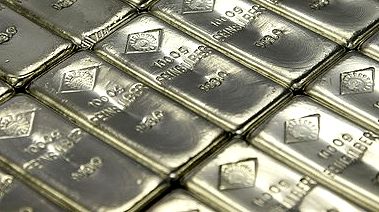
1 comment:
With BullionVault you may buy physical gold and silver bars at current market prices.
Your bullion is kept at one of 5 secure global vaults. And you are able to sell it online or take away physical bars.
Post a Comment